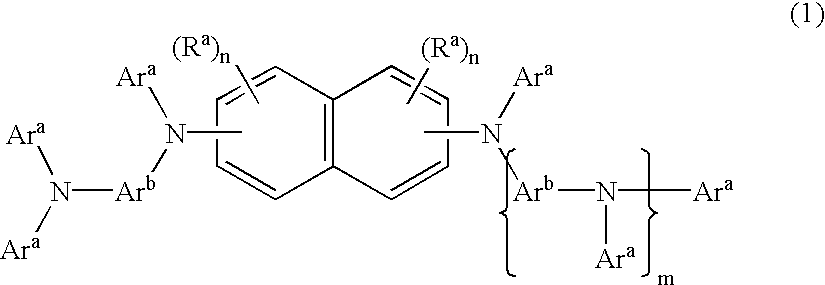Organic electroluminescent devices with high luminance
a technology of electroluminescent devices and organic materials, applied in the direction of discharge tube luminescnet screens, other domestic articles, natural mineral layered products, etc., can solve the problems of performance limitations that have been a barrier to many desirable applications
- Summary
- Abstract
- Description
- Claims
- Application Information
AI Technical Summary
Problems solved by technology
Method used
Image
Examples
example 1
Preparation of N,N′-Diphenyl-1,5-diaminonaphthalene
1,5-Diaminonaphthalene (2.5 g, 15.8 mmol) was combined with iodobenzene (7.1 g, 34.8 mmol), palladium diacetate (100 mg, 0.5 mmol), tri-t-butylphosphine (0.3 mL), sodium t-butoxide (4.0 g, 41.6 mmol), and toluene (60 mL). The mixture was heated at 110° C. with magnetic stirring under a nitrogen atmosphere. After 2 h, an additional amount of palladium diacetate (100 mg, 0.5 mmol) was added. After heating for another 2 h, the heat was removed. After cooling to room temperature, the solid present was collected and washed with acetone. The solid was combined with hot acetone (150 mL) and the solution was filtered. The product precipitated on cooling (1.3 g, 26%).
Preparation of Compound 1 (Inv-1): N,N′-Diphenyl-1,5-diaminonaphthalene (1.5 g, 4.8 mmol), 4-bromo-N,N-di-p-tolylaniline (3.4 g, 9.7 mmol), palladium diacetate (150 mg, 0.7 mmol), tri-t-butylphosphine (0.6 mL), sodium t-butoxide (1.1 g, 11.5 mmol), and xylene (75 mL) were combin...
example 2
Preparation of Compound 2 (Inv-2)
N,N′-Diphenyl-1,5-diaminonaphthalene (1.55 g, 5.0 mmol), 4-bromo-N,N-diphenylaniline (3.24 g, 10.0 mmol), palladium diacetate (150 mg, 0.7 mmol), tri-t-butylphosphine (0.6 mL), sodium t-butoxide (1.1 g, 11.5 mmol), and xylene (75 mL) were combined and heated to 130° C. for 2.5 h with magnetic stirring under a nitrogen atmosphere. The heat was removed and after cooling to room temperature the reaction mixture was filtered. The filtrate was evaporated and the resulting solid was purified by column chromatography (silica gel, 30% dichloromethane, 70% heptane) and sublimed (355° C., 6×10−1 torr) affording 1.6 g of product (40% yield). The Tg of this material was 119° C.
example 3
EL Device Fabrication and Performance
A series of EL devices satisfying the requirements of the invention were constructed in the following manner:
A glass substrate coated with an 42 nm layer of indium-tin oxide (ITO) as the anode was sequentially ultrasonicated in a commercial detergent, rinsed in deionized water, degreased in toluene vapor and exposed to oxygen plasma for about 1 min.
a) Over the ITO was deposited a 1 nm fluorocarbon hole-injecting layer (CFx) by plasma-assisted deposition of CHF3.
b) A first layer of Compound 1 (Inv-1, see Table 1 for layer thickness) was then deposited over the CFx by evaporation from a tantalum boat.
c) A hole-transporting layer of N,N′-di-1-naphthalenyl-N,N′-diphenyl-4, 4′-diaminobiphenyl (NPB, see Table 1 for layer thickness), was then evaporated from a tantalum boat.
d) A 75 nm light-emitting / electron transport layer of tris(8-quinolinolato)aluminum (III) (AlQ3) was then deposited onto the hole-transporting layer. This material was also evaporate...
PUM
| Property | Measurement | Unit |
|---|---|---|
| thick | aaaaa | aaaaa |
| organic | aaaaa | aaaaa |
| luminance | aaaaa | aaaaa |
Abstract
Description
Claims
Application Information
 Login to View More
Login to View More - R&D
- Intellectual Property
- Life Sciences
- Materials
- Tech Scout
- Unparalleled Data Quality
- Higher Quality Content
- 60% Fewer Hallucinations
Browse by: Latest US Patents, China's latest patents, Technical Efficacy Thesaurus, Application Domain, Technology Topic, Popular Technical Reports.
© 2025 PatSnap. All rights reserved.Legal|Privacy policy|Modern Slavery Act Transparency Statement|Sitemap|About US| Contact US: help@patsnap.com



